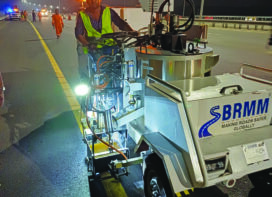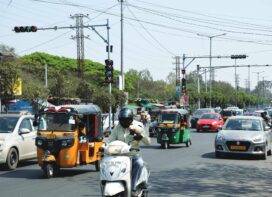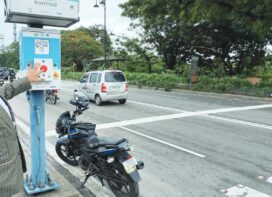
Technology has revolutionized road safety in India. It enables you to control traffic, catch lawbreakers, and provide road safety. While listing out some of the important solutions, Dr Zafar Khan, Head – Operations, Peak Infrastructure Management Services Pvt Ltd states that to make an infrastructure project work successfully, there is a need for effective collaboration between technology providers and developers

India has the second largest road network in the world, spanning a total of 5.89 million kilometres. This road network transports 64.5% of all goods in the country. 90% of India’s total passenger traffic uses the road network to commute. According to a study, one person dies every four minutes in road accidents in India, estimating the cost of such accidents at INR 3.8 lakh crores or 3% of the GDP. As a signatory to the Brasilia Declaration, India is committed to reducing the number of road accidents and fatalities by 50% by 2020. If we are to keep this commitment, the use of technology in any and every aspect of road safety is essential. We will have to take a systematic approach and encourage innovation in automotive components, vehicle safety and road engineering, including leveraging vehicle data management, connectivity, driving apps and dark spot identifications, as these will play a major role in improving road safety on Indian roads. Minister of Road Transport and Highways, Nitin Gadkari, has frequently spoken about the government’s intention to leverage technology to improve road safety. Here’s a look at some technology solutions that could help make Indian roads safer.

- Cooperative Intelligent Transport Systems
- Intelligent Speed Adaptation
- Smart signs
- Smart camera crash prevention
- Roadside collision avoidance
- Night vision
- Driver fatigue detection and warning
- Collision avoidance technology systems
Road safety is crucial and the Government intends to leverage technology for augmenting the safety of citizens. The technology enables you to control traffic, catch the lawbreakers, and provide road safety.
LIDAR Gun
Light Detection and Ranging gun is a weightless and simple tool, which enables law officials to catch and book vehicles that crosses the speed limit. With the invisible infrared beam in the gun, you will be able to target individual vehicles and recognize whether a particular vehicle is violating the speed limit or not, on the basis of variations recorded in the light.
Moreover, the device estimates the vehicle’s speed within a second and is devoid of errors. Apart from that, the gun also assists you to establish the distance between two vehicles and detect instances of tailgating. The device enables you to capture and record images of license plates. It has already been implemented by traffic authorities in the US and the UK.
Speed Indication Display
Warning signs can be beneficial for road users. The speed indication displays – that serve as a warning sign – are digital speed boards which are installed on roads for identifying whether a vehicle crosses the speed limit or not. These devices are installed along with a radar sensor, and can evaluate the speed of the vehicle, which is displayed on the LED displays, visible to all vehicles. Today, a wide range of speed indication display devices is available; while some display the vehicles which are driving under and over speed limits, others display the real-time speed of each vehicle. At times, the device captures and stores images of speeding vehicles. Speed Indication Displays have been implemented in Singapore and UK, and the Indian Government has already suggested the installation of these devices in its scheduled ‘Integrated Traffic Management System’.
Speed Governors
Speed governors, as the name implies, allow you to recognize when a vehicle crosses the decided speed limit. With the sensors attached to the device, you can recognize how swiftly a vehicle is going, and whenever the vehicle attempts to cross the speed limit, it will restrict the air flow and engine fuel. Hence, the vehicle will automatically slow down and stop. Therefore, the speed governor is an ideal solution for vehicles to remain within the speed limit.

Variable message signs
Variable message signs are LED boards which display vital information to commuters. These signs are installed in Indian cities such as Bangalore and Hyderabad. Delhi is also planning to install the sign in the near future. As a
result, it serves of value to road users as they are able to receive the latest updates on the road and traffic conditions, especially that of vehicle breakdowns and traffic congestion.
Induction Loops
Induction loops are beneficial since they detect vehicles waiting at the junction and send this data to traffic signals, which change automatically based on the situation. These loops utilize electromagnetic fields and will
experience a change in frequency whenever a vehicle enters that particular area. The feedback obtained from it is transferred via connected cables. In addition to this, the type of vehicle can also be determined on the basis of the changes in frequency
Public Private Partnerships – the way forward
In most countries, traffic enforcement cameras and other road safety equipment are purchased, owned, and operated by government organizations. The past two decades have seen a wide-ranging wave of privatization and introduction of public private partnerships (PPP) in formerly government-owned or controlled activities, including traffic enforcement. Implementing this concept properly and successfully requires a set of principles and good practices.
Basic elements of an effective automated traffic enforcement PPP Model
a. A study to identify the intersections or road sections that have a history of injuries or fatalities with the sole goal of improving road safety at these sites. The study should confirm that – besides safety cameras – a range of road safety countermeasures have been considered and thoroughly evaluated for effectiveness.
b. A private party – either a supplier or a third party who is willing to supply the safety cameras for usage at no upfront charge to the public party, which could be a municipality, county, province, state, or nation, and provide a service to issue tickets and collect fines for traffic violations recorded by the safety cameras.
c. A contractual arrangement between the public and private party, allowing the private party to recover its investment over time by receiving an agreed and capped share of the revenue generated by the safety cameras. This contractual cap should not prevent the private party from
issuing further tickets, which means a reasonable per ticket fee to cover the private party’s additional costs should continue once the cap is reached.
d. No citations may be issued unless an authorized official has verified the offense after viewing the image or video of the incident.
e. The end-to-end integrity of the enforcement system (from cameras to back office processes) must be guaranteed
to ensure public trust and optimise efficacy and efficiency. An independent third party must be hired to formally approve and authorise usage, but also routinely inspect, verify and calibrate each camera to confirm the intended measurements and performances. An independent party should also monitor, inspect and verify that the entire enforcement process from violation registration to fine collection takes place according to agreed-upon performance and integrity indicators.
f. A clearly publicized campaign that promises that the sole objective of the automated enforcement operation is road safety improvement, and that all revenue above the expenses incurred by private parties (camera supplier and operator as well as the third party hired to audit the cameras and enforcement processes) will be reinvested only in road safety related projects.
Controversial issues with enforcement of PPP model:
a. Not road safety, but revenue driven
b. Alleged collusion and corruption
c. Enforcement cameras do not contribute to road safety
d. Limits other road safety initiatives by public parties
We must develop some checks and balances to create transparency and integrity:
- Ultimate control and approval of violations only by police or authorised officials
- Independent approval and regular verification of accuracy and overall performance
- Surplus fine revenue to be reinvested into road safety projects
- Longer term contract with capped revenue
- Maintain lower financial incentive to continue to issue tickets beyond cap
In India, there is a huge potential for such PPP models but the authorities and private investors are still not finding a balance, and are unable to create a clean, non- profit, safety objective-driven campaign to reduce road fatalities. But in the future, as more and more international investor-driven platforms will operate these roads, these models could be a reality soon.
 TrafficInfraTech Magazine Linking People Places & Progress
TrafficInfraTech Magazine Linking People Places & Progress


